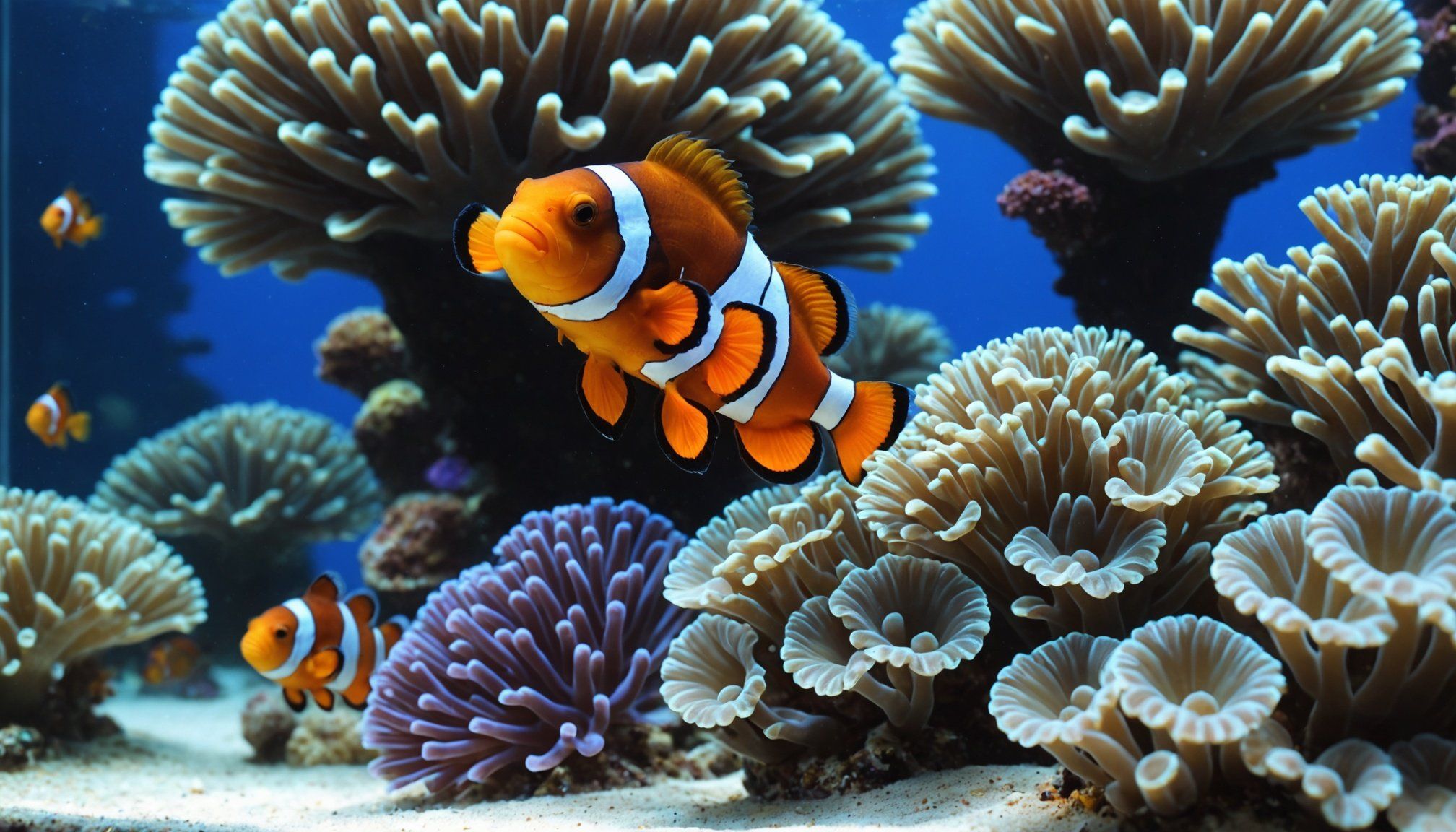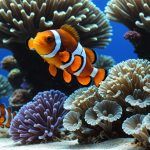Introduction to Saltwater Clownfish Aquariums
Saltwater clownfish are among the most sought-after species for marine aquariums due to their vibrant colours and unique personalities. Before setting up a clownfish aquarium, understanding these captivating creatures’ needs is crucial for a successful and thriving habitat. Clownfish are resilient but require specific conditions to flourish, hence the need for careful planning and preparation.
This beginner’s guide aims to provide a comprehensive blueprint for starting and maintaining a successful clownfish aquarium. From selecting the proper aquarium setup to maintaining ideal water conditions, this guide will walk you through each step, ensuring your clownfish feel at home in their new environment.
Additional reading : Irresistible Training Treats to Inspire Even the Most Stubborn Pugs!
Given their popularity, clownfish are often the first choice for beginners and experienced aquarists. However, their care involves more than just filling a tank with water. It requires understanding their interaction with the environment and the equipment needed to support their habitat. This section will outline the essentials you need to consider when setting up your clownfish aquarium, ensuring your journey into marine biology is smooth and rewarding. Follow the guidelines to create an aquarium setup that mimics the natural reef environment as closely as possible.
Selecting the Right Aquarium Size
Choosing the ideal aquarium size is critical in creating a healthy environment for your clownfish. Many aquarists wonder: “What tank size is best for clownfish?” For a beginner’s setup, a 20-gallon tank is often recommended, as it comfortably accommodates two clownfish with room for more marine life. This size considers the mature size of clownfish, ensuring ample space for swimming and reducing stress.
Also to see : The Definitive Handbook on Boundary Training: Effective Strategies for Instilling Respect in Your Puppy
Tank dimensions significantly influence clownfish behaviour and health. A longer tank, for example, allows for more swimming space, enhancing their natural activity patterns. Moreover, when planning your aquarium, don’t just consider your clownfish. If you wish to introduce additional species or corals, you’ll need a larger tank to prevent overcrowding and maintain a balanced ecosystem.
Remember that the bioload—the waste produced by the tank’s inhabitants—increases with each additional resident. Therefore, ensuring proper aquarium setup and planning for future additions is vital in maintaining a thriving habitat. As you decide on the dimensions, bear in mind the commitment to regular maintenance, which larger tanks demand. This thoughtful approach will lead to a healthy, harmonious clownfish habitat.
Essential Equipment for Your Aquarium
To establish a healthy clownfish habitat, acquiring the right aquarium equipment is essential. Start with a robust filtration system, which is critical for maintaining water quality. Filters remove waste and toxins, replicating natural ocean currents. Choose a filter that suits the size of your aquarium to ensure efficient water circulation.
Heaters are also necessary to maintain stable water temperatures, as clownfish thrive in warm, tropical environments. Ensure your heater can sustain a consistent temperature between 24-27°C, which is ideal for saltwater aquariums.
Another critical element is the lighting setup. Proper lighting not only showcases the vibrant colours of your clownfish but also supports photosynthesis if you include corals. Consider LED or T5 fluorescent lights, as they are energy-efficient and provide the full spectrum needed for marine life.
To further enhance water circulation, introduce powerheads or wavemakers, maintaining a gentle but steady flow throughout the tank. This simulates the natural coral reef environment, promoting the well-being of your aquatic inhabitants.
Investing in the right aquarium equipment ensures a thriving ecosystem, enhancing both the visual appeal of your tank and the health of your clownfish. Regular equipment checks will prevent issues, allowing your aquatic environment to flourish.
Understanding Water Parameters
Maintaining the right water quality is vital for the health of your clownfish. Key parameters to monitor include salinity, pH levels, ammonia, nitrite, and nitrate. For the correct salinity, aim for a specific gravity between 1.020 and 1.025. pH levels should remain stable between 8.0 and 8.4. These conditions replicate the natural environment of saltwater clownfish.
Regular testing is crucial. Use reliable kits or electronic monitors for accurate readings. This ensures that any deviations are quickly addressed before they threaten the ecosystem. Ammonia and nitrite should be kept at zero, indicative of a well-cycled aquarium. Nitrates should remain below 20 ppm to avoid stressful conditions.
Adjusting these parameters might involve adding commercial buffers or conditioners to the water. Conduct changes gradually to prevent shocking the fish. Keeping salinity and pH levels consistent is fundamental to your clownfish’s wellbeing. Their health and colour vibrancy are reliant on stable water conditions.
Developing an understanding of these parameters and their impact requires consistent evaluation. Mastering water quality ensures a thriving aquarium, fostering a balanced environment where both clownfish and other marine life flourish. This meticulous attention to water conditions supports both beginner and experienced aquarists alike.
Setting Up the Aquarium Environment
Creating a suitable aquarium environment is integral to your clownfish’s well-being. The journey begins with planning a thoughtful aquarium setup, focusing on rock placement and decorations. Rocks serve as foundations for a natural habitat, offering hiding spaces, which are crucial for reducing stress and encouraging natural behaviors.
Aquascaping closely mimics the natural reef structure, benefiting both fish and invertebrates. Striking a balance between open swimming areas and sheltered spots ensures clownfish can exhibit their territorial nature without feeling threatened.
Selecting appropriate substrates enhances the habitat’s appearance and functionality. sand or coral rubble provide a more natural look, beneficial for burrowing species or potential future reef additions. When choosing decorations, opt for materials that are safe for marine environments, avoiding sharp or toxic objects.
A well-structured aquarium promotes exploration and engagement, enhancing the health and vibrancy of its inhabitants. Get creative while respecting these principles, ensuring your aquarium not only meets aesthetic goals but also the biological needs of its marine life. Regularly rearrange or clean decorations to maintain a dynamic, clean, and enriching environment for your saltwater clownfish.
Choosing Compatible Species
Selecting compatible species is essential when establishing a reef tank with clownfish. Understanding the behaviour and territoriality of potential tank mates is crucial to maintaining harmony. Some suitable companions for clownfish include gobies, blennies, and certain species of damselfish.
Clownfish are generally peaceful but can exhibit territorial behaviour, especially over their chosen area within the reef tank. When introducing new marine species, consider the size and temperament, ensuring they won’t outcompete or threaten your clownfish.
When adding new fish to the aquarium, use the quarantine method to prevent disease introduction. Gradually acclimate them to the existing setup to reduce stress. Consider using a partition or introducing them during feeding times to divert attention.
Reef tanks often include corals and other invertebrates, which can coexist comfortably with clownfish. However, ensure the chosen species do not harm one another or the clownfish’s habitat. Compatibility involves trial and patience, and careful observation is necessary to maintain a peaceful and thriving aquarium environment. By following these guidelines, you can establish a dynamic yet harmonious marine community aligned with your clownfish’s social and environmental needs.
Feeding and Nutrition for Clownfish
Understanding the clownfish feeding regimen is crucial to maintaining their health and enhancing their vivid colours. A balanced diet typically consists of a mix of high-quality flakes, pellets, frozen foods, and occasional live foods. Feeding should occur once or twice daily, ensuring clownfish receive sufficient nutrition without overfeeding, which can disrupt the tank’s balance.
Nutrition influences not only the clownfish’s vitality but also their colour vibrancy. Incorporate a variety of foods to cover the nutritional spectrum, mirroring natural eating habits and promoting optimal health. For instance, supplementing their diet with omega fatty acids and vitamins supports robust immune function and enhances pigmentation.
Avoiding common feeding mistakes is vital; overfeeding can lead to waste that pollutes the tank, while underfeeding may lead to nutrition deficiencies. If dealing with picky eaters, gradually introduce new foods or mix them with favourites to encourage acceptance.
Regular observation during feeding time will help monitor their diet, enabling you to adjust portions and types as needed. Accurate attention to nutrition not only supports the well-being of your clownfish but contributes to a thriving aquarium ecosystem as a whole.
Regular Maintenance and Care
Proper aquarium maintenance is key to lasting health and vitality of your clownfish environment. Routine tasks include water changes, essential for diluting accumulated toxins and maintaining water equilibrium. Aim for weekly changes of 10-15% of the tank’s volume, ensuring stable conditions for your aquatic habitat.
Filter cleaning is equally crucial. Regularly inspect and rinse mechanical filters to prevent clogging, maintaining efficient filtration. Biological filters need particular care; handle them cautiously to preserve beneficial bacteria colonies vital for breaking down waste.
During system checks, observe your clownfish for any signs of distress or illness, such as lethargy, unusual spots, or rapid breathing. Quick detection enables prompt action, preventing disease spread.
Keeping the environment clean extends beyond water. Tackle algae buildup on glass and rocks by scrubbing it away, preventing excess light absorption and water quality issues. Trim or rearrange decorations if they hinder flow or create dead zones.
By adhering to this regimen, you’ll support a thriving aquarium ecosystem where your clownfish and their companions flourish. This commitment not only ensures aquatic inhabitants remain vibrant but also enhances the satisfaction of keeping a beautiful marine environment.
Avoiding Common Pitfalls
Avoiding common pitfalls when managing a clownfish environment ensures a successful and thriving aquarium. Many beginners make errors with water quality and fish behavior that can lead to stress or even loss of marine life. Recognising these mistakes early is essential.
One recurrent issue is incorrect water quality. New aquarists often struggle with maintaining the right parameters, leading to spikes in ammonia and nitrite. To counter this, adopt a routine of consistent parameter testing and gradual adjustments. Aim to avoid sudden changes that may shock the fish.
Overfeeding is another common mistake. Providing excessive food not only disrupts the tank’s balance but also increases the bioload, affecting water conditions. Stick to a well-balanced diet schedule to uphold the aquarium’s health.
Introducing incompatible marine species without understanding their behaviour leads to territorial disputes. Research each species’ requirements and temperament before adding them to the tank. Ensuring compatibility helps maintain harmony in the ecosystem.
Troubleshooting and learning from experiences are vital. Engage with community resources or consult experienced aquarists to deepen your knowledge. A proactive approach will help prevent issues and support a vibrant clownfish aquarium.










